

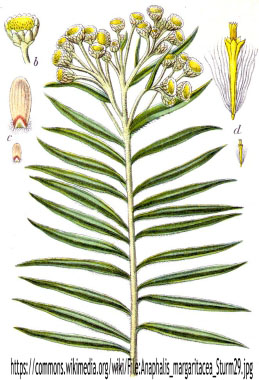
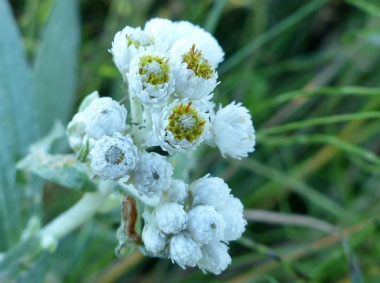
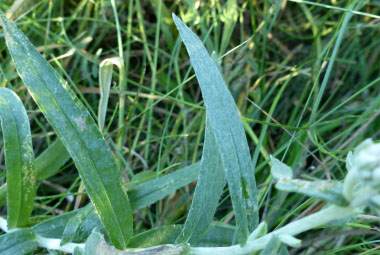

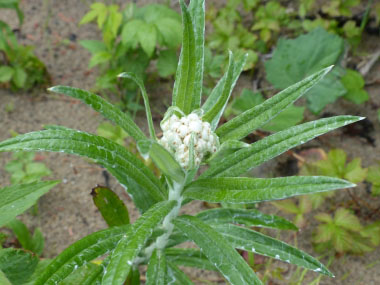
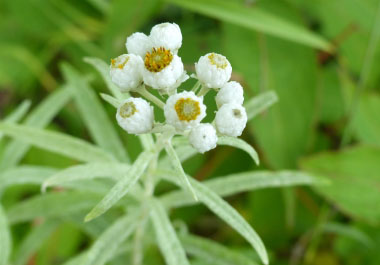
To support our efforts please browse our store (books with health benefits, etc.).
Pearly everlasting is a perennial native plant (in Canada and the U.S.) that is a member of the Asteraceae family. It is drought tolerant and a favourite food source for many butterflies. Pearly everlasting was often used medicinally by native North American Indian tribes who used it as treatment for a range of ailments. It has been used as a remedy for diarrhea and dysentery. An infusion of the plant is steamed and inhaled in the treatment of headaches.
Distinguishing Features
This plant is easily recognizable; it has small white button-like flowers with yellow centres. It forms a bushy mound of hairy silver-gray foliage but the flowers are easy to identify. One salient feature is that the undersides of the leaves are covered in tiny hairs, giving them a woolly feel and appearance. The stems are dry and brittle.
Flowers
Pearly everlasting flowers are generally flat-topped clusters of numerous 0.5cm to 1cm (¼ to 1/3”) flower heads at the top of the plant. This plant has male and female flowers, usually on separate plants. Male flowers are globular with numerous slender, erect yellowish brown staminate flowers in the yellow center disc. Female flowers are globular to egg-shaped with a yellowish to dark brown bristly ring around the top of the flower head. Both genders have what appear to be numerous tiny white petals in many layers around the centre (bracts). The bracts on the female flowers do not spread out much until seed starts forming. Flowers bloom July – October.
 Fields
of Nutrition has medicinal benefits and vitamin/mineral content of Pearly Everlasting.
Fields
of Nutrition has medicinal benefits and vitamin/mineral content of Pearly Everlasting.
Leaves
Leaves are 7 to 13cm (3 to 5”) long, and up to 2cm (¾ inch) wide. They are toothless, often with wavy or rolled edges, covered in white woolly hairs on both sides but moreso on the underside. Pearly everlasting leaves are sharply pointed at the tip with no leaf stalk. They grow alternate.
Height
This plant can grow anywhere from 30cm to 1 metre (1 to3') tall. Stems are densely covered in woolly white hairs.
Habitat
Pearly everlasting prefers growing in sunny locations althoughtit can be found in part shady areas as well. It likes dry fields, along roadsides, disturbed soils, and the edges of wooded areas. This plant grows in Canada, the U.S., several countries in Europe, India, Japan, eastern Russia, South Korea, China and in several areas in the Himalayan Mountains.
Edible Parts
Young leaves are edible when cooked.
Other Name
Western Pearly Everlasting.
Winter Survival Food Handbook

PDF Plant Magazines
Types of Wild Food
Geographic Zones Seasons
Disclaimer
EdibleWildFood.com is informational in nature. While we strive to be 100% accurate, it is solely up to the reader to ensure proper plant identification. Some wild plants are poisonous or can have serious adverse health effects.
We are not health professionals, medical doctors, nor are we nutritionists. It is up to the reader to verify nutritional information and health benefits with qualified professionals for all edible plants listed in this web site. Please click here for more information.
Why Edible Wild Food?
- Food costs are rising
- Free, wild food is readily abundant
- Wild food adds nutrition to your diet
- Wild food can help treat various medical conditions





